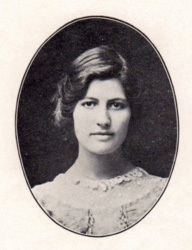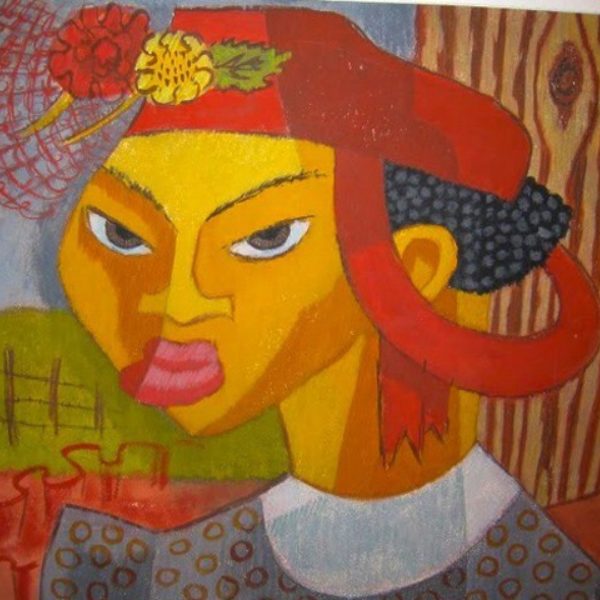
Kathleen Blackshear
b. 1897, Navasota, TX - d. 1988, Navasota, TX
Kathleen Blackshear was born in the Texas cotton belt. She grew up spending summers on the nearby cotton plantations of both her maternal and paternal families close to Navasota, a town founded by her grandfather. It was there that she became friends with the children of the African Americans who picked cotton for her family; this experience would have great significance in her later career, both as an artist and teacher. She began art lessons at age 12, copying magazine illustrations, and went on to earn a bachelor’s degree in modern languages from Baylor University in Waco in 1917. She studied at the Art Students League in New York, where her teachers included Solon Borglum, George Bridgeman, and Frank Vincent DuMond. In 1918, she left New York and spent the next six years travelling and exploring career options in Los Angeles, New Orleans, Europe, and Mexico, continuing to produce photographs, prints, paintings, and sculpture
Blackshear moved to Chicago in 1924, where she attended the School of the Art Institute of Chicago (SAIC) to study painting and graphic arts. The art history class taught by Helen Gardner that she took in 1925 proved pivotal. Gardner became a mentor and inspiration to Blackshear, who began teaching art history the following year, continuing until her retirement in 1961. Like Gardner—whose widely used textbooks, Art Through the Ages (1926) and Understanding the Arts (1932), she illustrated—Blackshear introduced modernist ideas in her courses. She did not teach the standard history of classical through Renaissance art, but included a wide variety of non-western, pre-Renaissance, and progressive, twentieth-century art in her classes. She sent students to explore not just the galleries of the Art Institute, but the Field Museum of Natural History, the Shedd Aquarium, the Oriental Institute, and the local zoos for inspiration. In this way, she influenced generations of students at SAIC to discover idiosyncratic sources and connections with cultures other than their own, laying the groundwork for later Chicago artists of the Monster Roster and Imagist movement. Blackshear was particularly influential in inspiring and supporting the careers of the African American students in her classes, such as Margaret Burroughs. She also made two dioramas for the 1933 Century of Progress Exposition in Chicago, and illustrated Art Has Many Faces by Katherine Kuh.
Blackshear frequently depicted African Americans, often inspired by her summer visits to Texas and her childhood memories but also by her experiences in Chicago. Her lithograph, Untitled (Woman mopping) sympathetically depicts a sturdy washerwoman mopping, in a generalized style typical of the American Scene and regionalist styles of the Depression era. Blackshear renders her head at an unnatural angle as if to emphasize the backbreaking work, and her heavy, bulky form suggests that she has and will continue to spend hours performing this monotonous task. It exemplifies why critic C. J. Bulliet called her “Chicago’s most sympathetic, most understanding painter of the American Negro” in 1939. Bulliet continued: “Her Negroes in these slight but expert drawings live and breathe a happy, wholesome life,” though he was quick to qualify that she was not a Communist recruiter.
Blackshear maintained a studio in Houston and spent many summers at her home in Navasota, where she retired in 1961, with her partner, Ethel Spears. She also sketched in Arizona, New Mexico, and Mexico.
Blackshear’s work was exhibited at the Art Institute of Chicago, Chicago Society or Artists; Witte Memorial Museum, San Antonio, TX; Museum of Fine Arts, Houston; Museum of Fine Arts, Dallas; among others. Her works also are held in the Art Institute of Chicago.
Susan Weininger and Lisa Meyerowitz
References
Bulliet, C. J. “Artists of Chicago Past and Present: No. 97: Kathleen Blackshear.” Chicago Daily News, July 29, 1939.
Illinois Women Artists Project, http://iwa.bradley.edu/?q=artists/KathleenBlackshear.
Kovinick, Phil, and Marian Yoshiki-Kovinick. An Encyclopedia of Women Artists of the American West. Austin: University of Texas Press, 1998.
Landauer, Susan, and Becky Reese. “Lone Star Spirits.” In Patricia Trenton, ed. Independent Spirits: Women Painters of the American West, 1890–1945, 199–200. Los Angeles: University of California Press, 1995.
Tormollan, Carole. A Tribute to Kathleen Blackshear. Chicago: School of the Art Institute of Chicago, 1990.
Tormollan, Carole. “Kathleen Blackshear.” In Women Building Chicago: 1790-1990, edited by Rima Lunin Schultz and Adele Hast, 84–86. Bloomington: Indiana University Press, 2001.
Weininger, Susan. “Kathleen Blackshear.” In Elizabeth Kennedy, ed. Chicago Modern, 1893–1945: Pursuit of the New, 92. Exh. cat. Chicago: Terra Foundation for the Arts, 2004.
Yochim, Louise Dunn. Role and Impact: The Chicago Society of Artists, 222. Chicago: Chicago Society of Artists, 1979.
Artist Image: Kathleen Blackshear / unidentified photographer. Navasota (TX) High School Annual.
